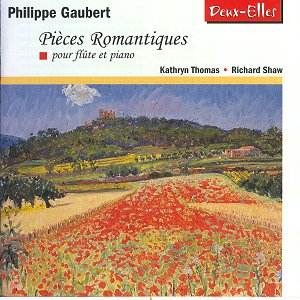Philippe
GAUBERT
Pièces Romantiques pour flûte
et piano
 Kathryn Thomas (flute) & Richard Shaw
(pf), Phoebe Scott (cello)
Kathryn Thomas (flute) & Richard Shaw
(pf), Phoebe Scott (cello)
 Deux-Elles DXL 923 (73'17, Full Price)
Deux-Elles DXL 923 (73'17, Full Price)
Buy
through MusicWeb
for £13.30/14.80 postage
paid World-wide.
You may prefer to pay by Sterling
cheque or Euro notes to avoid PayPal. Contact
 for
details
for
details
Purchase
button
Visit our partner ArkivMusic
for
sale in USA, Canada, UK, Australia, New Zealand
and Japan

Sonate flûte et piano
Deuxième Sonate flûte et piano
Troisième Sonate flûte et piano
Madrigal flûte et piano
Orientale flûte et piano
Trois Aquarelles flûte cello et piano
Pièce Romantique flûte cello et piano
Phillippe Gaubert, who died in 1941, left an indelible impression on flute
playing, particularly in the United States. He was the first major flautist
to adopt the open hole standard of playing and many of his students emigrated
to the US to take up principal positions with the great American orchestras
in Boston, Philadelphia, Chicago and New York. To this day, one can still
hear the sense of timbre, control and silvery tone which Gaubert taught.
Homogenised it may sound, but with tempered use of vibrato it can be often
seduce the ears in evocative and poetic ways.
Not surprisingly, his compositions display many of these attributes. These
are often works which stand musically apart from the tempestuous politics
of the time. The First Sonata, for example, was composed in 1917 - and yet
none of the fragility or despondency of a world order on the brink of calamity
can be sensed in any of its three movements. The intense poetry of the middle
Lent stands next to the optimism and enthusiasm of the outer movements.
There is almost no stylistic development from this earliest work and the
later sonatas from 1924 and 1933 - the mood is tangentially optimistic and
laden with Debussyesque cadences.
If the style is traditionally French - just as Prokofiev's for his flute
sonata was authentically Russian - this is not necessarily a drawback. But
one encounters the same difficulties listening to this disc in one sitting
as one would with the Ysaye violin sonatas - an element of repetitiveness
and lack of invention, something one never encounters with the masters of
French Impressionism, Debussy and Ravel. Taken as individual works interspersed
with something else they are a miraculous tonic for a typically wet London
morning.
Fortunately, Kathryn Thomas has a glorious tone - and her sense of the dynamic
range of these works is finely attuned. This is particularly so in the
Pièce Romantique, more akin to Chausson, but almost orchestral in
some of its textures (listen to the flute's entrance after the piano and
cello obilgato). Thomas' playing is always relaxed and loose, the sound often
rich and reedy. None of the metallic hollowness one can sometimes associate
with the steel flute appears evident on this clean and atmospheric recording.
The nervousness which can sometimes accompany her London recitals has,
thankfully, been overcome. Her playing brims with confidence and lustre -
and she has fine accompanists in Richard Shaw and Phoebe Scott.
This is undoubtedly a beautiful disc - and a beautifully played one.
Marc Bridle
Performance and Recording

But Peter Woolf is not quite so sure:
This recital by a solo flautist, an excellent player who is prominent on
the London scene, is a disappointment, despite Kathryn Thomas doing all for
Philippe Gaubert that is possible.
I enjoyed one of these sonatas (probably the third) in a mixed recital she
gave recently, but putting all three together reveals the composer's poverty
of invention and reliance upon smooth melody, with repetitions of small phrases
and, far too often, simple arpeggiated piano accompaniment. It is all too
bland for my taste, though the CD has won plaudits elsewhere.
To characterise it, I hope not too unkindly, it is music for undemanding
listening, maybe very suitable for including in Classic FM programmes. But
for that, the presentation is lacking in essentials, and pianist Richard
Shaw might have benefitted from editorial help. Although it is generously
filled at 73 minutes, no timings are given for the fifteen individual tracks
(four with cello as well as piano) - essential for radio programme producers!
We are told of Gaubert's considerable fame as a conductor and of the success
of his last ballet in 1941, very shortly before he died, but not his date
of birth (Gaubert, Philippe (b Cahors, Lot, 5 July 1879; d Paris, 8 July
1941). French flautist, conductor and composer [New Grove 2nd Edition].
On this CD's showing, that order is probably right; he was a flute prodigy
and accompanied Melba on her tours (no doubt playing the obbligatti for the
mad scenes). The pieces are all a little too comfortable and there is little
scope to explore the potential of Kathryn Thomas's (one) flute. It will however
be welcome for flute students and for professional flautists looking to widen
their recital repertoires. I look forward to Kathryn Thomas's next CD and
am sure she will want to choose more demanding and varied repertoire.
Peter Grahame Woolf

